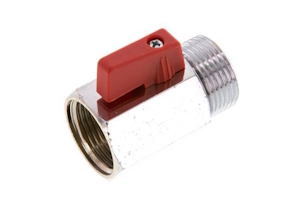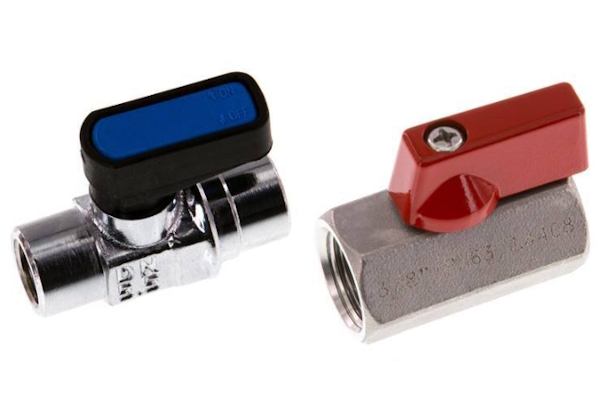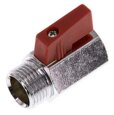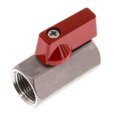Mini Ball Valve Overview

Figure 1: A male to female mini ball valve
Mini ball valves' compact size and lightweight design make them valuable for systems where space and weight are critical, offering significant advantages over larger, standard ball valves. This article overviews the selection process for mini ball valves and explores their diverse applications, highlighting their importance in comparison to standard ball valves.
Table of contents
View our online selection of mini ball valves!
Mini vs standard ball valves
There are no specific requirements for a ball valve to be considered a mini ball valve instead of being considered a small standard ball valve. However, mini ball valves are smaller, designed for applications needing control in compact spaces. They can be operated manually or electronically, with electronic versions equipped with control systems for remote operation. In contrast, standard ball valves are used for larger systems requiring higher flow rates. While both types offer similar functionality, mini ball valves are specifically designed for lower flow rates and smaller systems.
Example
The following mini and standard ball valves demonstrate the flow rate differences between mini and standard ball valves. All ball valves listed below are made of brass and have 3/4" port sizes. The values listed after each ball valve are the valves' Kv values.
Mini ball valves
- Male To Female G 3/4 inch 2-Way Brass Mini Ball Valve 15 Bar: 5 m3/h
- G 3/4 inch 2-Way Brass Mini Ball Valve 15 Bar: 5 m3/h
Standard ball valves
- G 3/4 inch Butterfly Handle Compact 2-Way Brass Ball Valve: 29.5 m3/h
- Rp3/4'' 2-Way Ball Valve Brass PTFE/NBR 25 bar: 24 m3/h
Construction
Mini ball valves are typically constructed from durable materials such as brass or stainless steel (Figure 2), each chosen for their specific properties and suitability for different applications. Common sizes are 1/8" mini ball valves to 3/4" mini ball valves.

Figure 2: A brass (left) and stainless steel (right) mini ball valve.
Brass mini ball valves
Brass mini ball valves are constructed with the following materials:
- Housing: Chrome-plated brass, providing corrosion resistance and durability.
- Ball: Hard chromium-plated brass, ensuring smooth operation and longevity.
- Seal: PTFE (Polytetrafluoroethylene) and NBR (Nitrile Butadiene Rubber), offering excellent sealing properties and chemical resistance.
These valves are designed to operate within a temperature range of 0 °C to 90 °C (32 °F to 194 °F) and are suitable for use with water (excluding steam), neutral gaseous and non-aggressive liquid media, mineral oils, compressed air, and vacuum applications (up to -0.9 bar or -13.05 psi).
Stainless steel mini ball valves
Stainless steel mini ball valves are constructed with the following materials:
- Housing: 1.4401 or 1.4408 stainless steel, known for its high resistance to corrosion and aggressive media.
- Ball: 1.4408 stainless steel
- Handle screw: 1.4301 stainless steel, ensuring secure attachment of the handle.
- Seal: PTFE and FKM (Fluoroelastomer)
- Handle: Made from polyamide or zinc die casting, providing a sturdy and ergonomic grip.
These valves can operate within a broader temperature range of -20 °C to 200 °C (-4 °F to 392 °F), making them suitable for more demanding applications. They are designed for use with water, oil, compressed air, vacuum (up to -0.9 bar or -13.05 psi), fuels, solvents, and aggressive media.
Applications
For the most part, mini ball valves are used in the same settings that standard ball valves are used in. Learn more in our article about ball valve applications. If a ball valve is suitable for an application, consider whether or not the system parameters require a mini ball valve. Certainly, these valves are preferable if space is limited, but it's also critical that they are able to handle other system factors, such as flow rate.
Installation
The process for installing a mini ball valve follows the same steps as most valve types, such as preparing the installation surface (e.g., pipe), ensuring the ports are clean of debris, and testing the valve afterwards. Read our article on ball valve installation for more specific information.
FAQs
What are mini ball valves used for?
They are used for controlling fluid flow in various industrial and commercial applications, specifically applications that have space constraints.
Can mini ball valves handle high pressure?
Yes, they can handle pressures up to 15 bar.
Are mini ball valves suitable for steam applications?
No, mini ball valves are not suitable for steam or corrosive/aggressive media.







